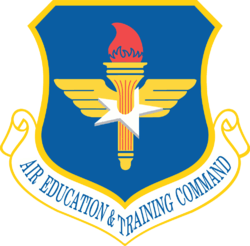534th Training Squadron
534th Training Squadron
 | |
|---|---|
| Active | 1942-1945; 1994–2003 |
| Country |
|
| Branch |
|
| Role | Satellite control training |
| Part of | Air Education and Training Command |
| Engagements | European Theater of Operations |
| Decorations | Distinguished Unit Citation[1] |
| Insignia | |
| 534th Training Squadron emblem |
|
| 534th Bombardment Squadron emblem (approved 11 September 1944)[1] |
 |
The 534th Training Squadron is an inactive United States Air Force unit. It was last assigned to the 381st Training Group at Vandenberg Air Force Base, California, where it conducted qualification training for airmen in satellite control operations and maintenance.
During World War II, the squadron engaged in combat in the European Theater of Operations as the 534th Bombardment Squadron, earning two Distinguished Unit Citations. It was inactivated after V-E Day, but was active in the reserve from 1947 to 1949, although it is not clear whether it was fully equipped or manned.
History
World War II
Established in late 1942 as a Boeing B-17 Flying Fortress heavy bombardment squadron; it trained under II Bomber Command in Washington, Texas and Idaho. It received deployment orders for the European Theater of Operations in May 1943.
The squadron was assigned to VIII Bomber Command in England in June 1943, at RAF Ridgewell. The unit's mission was to conduct strategic bombardment operations over Occupied Europe and Nazi Germany. It operated chiefly against strategic objectives on the Continent. It participated in the intensive bombing campaign against enemy aircraft factories during Big Week, 20–25 February 1944, the Group often supported ground troops and attacked targets of interdiction when not engaged in strategic bombardment.
The squadron supported the Normandy invasion in June 1944 by bombing bridges and airfields near the beachhead. It attacked enemy positions in advance of ground forces at Saint-Lô in July 1944. The squadron assisted the airborne assault on the Netherlands in September. It struck airfields and communications near the battle zone during the Battle of the Bulge, December 1944 - January 1945. It also supported the Allied crossing of the Rhine in March 1945 and then operated against communications and transportation in the final push through Germany.
After V-E Day, the unit returned to Sioux Falls Army Air Field, South Dakota in July 1945, although many combat personnel were demobilized upon their return to the United States. A small cadre of personnel were formed with replacement personnel assigned. The unit was programmed for conversion to B-29 Superfortress very heavy bombers; however, no aircraft were assigned. The Japanese capitulation in early August led to the units' inactivation on 28 August, with personnel either reassigned to other units or demobilized.
Reserves
The squadron was reactivated in the reserve in February 1947 at Sioux City Army Air Base, Iowa. Having been allotted to the organized reserves, with assignment to the Second Air Force, Air Defense Command. In late September 1947, the squadron was again assigned to the 381st Bombardment Group. In July 1948, the group was reassigned from the Second Air Force to the Tenth Air Force, which in December, became a part of the Continental Air Command. The 534th Squadron was inactivated on 27 June 1949 due to budget restrictions.
Space training
The squadron was again activated in the fall of 1994 as the 534th Training Squadron when Air Education and Training Command assumed space and missile systems training at Vandenberg Air Force Base, California from Air Combat Command and Air Force Space Command. The 534th was responsible for initial qualification training for crews in satellite command and control. In 2003, the 534th was inactivated and its training programs were transferred to the 533d Training Squadron.[2]
Lineage
- Constituted as the 534th Bombardment Squadron (Heavy) on 28 October 1942
- Activated on 3 November 1942
- Redesignated 534th Bombardment Squadron, Heavy on 20 August 1943
- Inactivated on 28 August 1945.
- Redesignated 534th Bombardment Squadron, Very Heavy on 28 January 1947
- Activated in the reserve on 27 February 1947
- Inactivated on 27 June 1949[1]
- Redesignated 534th Training Squadron on 4 August 1994
- Activated on 1 October 1994
- Inactivated in 2003[2]
Assignments
- 381st Bombardment Group, 3 November 1942 – 28 August 1945
- Second Air Force, 27 February 1947
- 381st Bombardment Group, 15 Sep 1947
- 351st Bombardment Group, 3 May 1948 – 27 Jun 1949[1]
- 381st Training Group, 1 October 1994 – 2003[2]
Stations
- Gowen Field, Idaho, 3 November 1942
- Ephrata Army Air Base, Washington, 1 December 1942
- Pyote Army Air Field, Texas, 27 December 1942
- Pueblo Army Air Base, Colorado, 6 April–10 May 1943
- RAF Ridgewell (AAF-167),[3] England, 2 June 1943 – 24 June 1945
- Sioux Falls Army Air Field, South Dakota, 3 July–28 August 1945
- Sioux City Army Air Base, Iowa, 27 February 1947 – 27 June 1949[1]
- Vandenberg Air Force Base, California, 1 October 1994 – 2003[2]
Aircraft
- Boeing B-17 Flying Fortress, 1942-1945
- B-29 Superfortress, 1947-1949[1]
References
- Notes
Bibliography
![]()
- Anderson, Capt. Barry (1985). Army Air Forces Stations: A Guide to the Stations Where U.S. Army Air Forces Personnel Served in the United Kingdom During World War II (PDF). Maxwell AFB, AL yes: Research Division, USAF Historical Research Center. Archived from the original (PDF) on January 23, 2016. Retrieved June 28, 2017.
- Maurer, Maurer, ed. (1983) [1961]. Air Force Combat Units of World War II (PDF) (reprint ed.). Washington, DC: Office of Air Force History. ISBN 0-912799-02-1. LCCN 61060979. Retrieved December 17, 2016.
- Maurer, Maurer, ed. (1982) [1969]. Combat Squadrons of the Air Force, World War II (PDF) (reprint ed.). Washington, DC: Office of Air Force History. ISBN 0-405-12194-6. LCCN 70605402. OCLC 72556. Retrieved December 17, 2016.